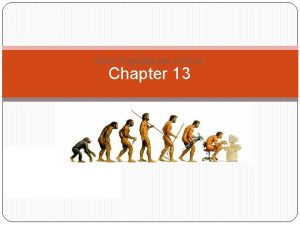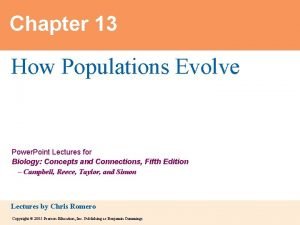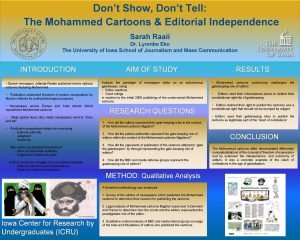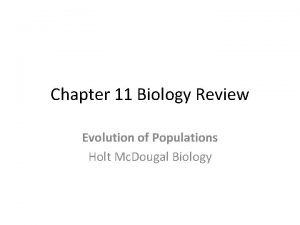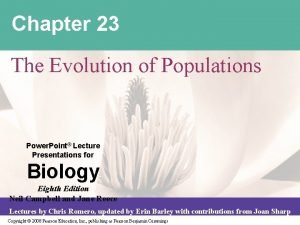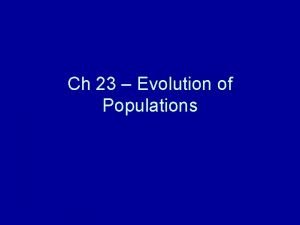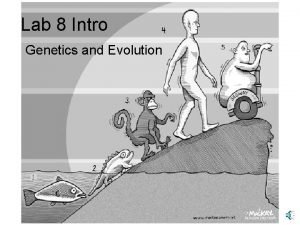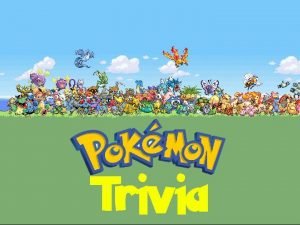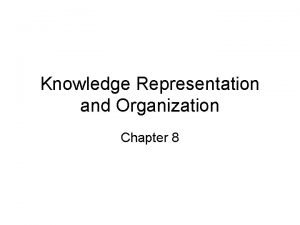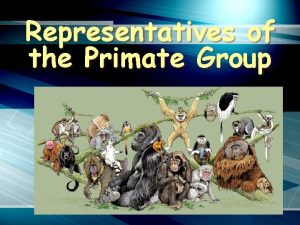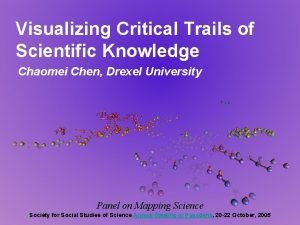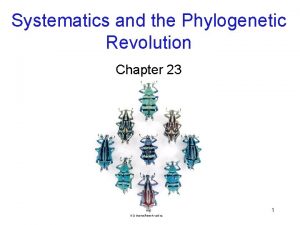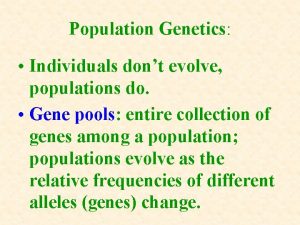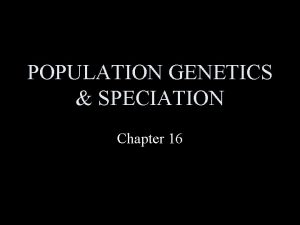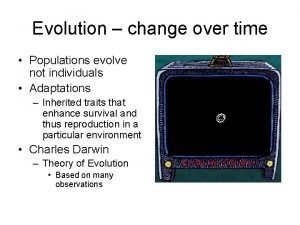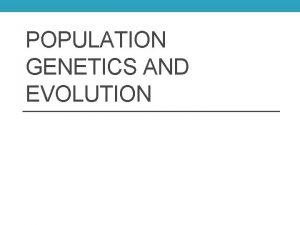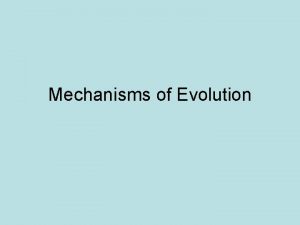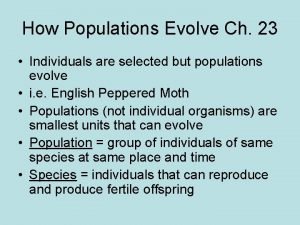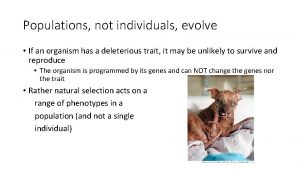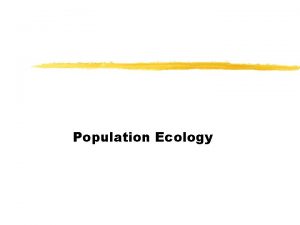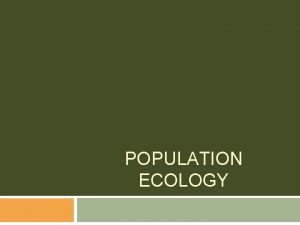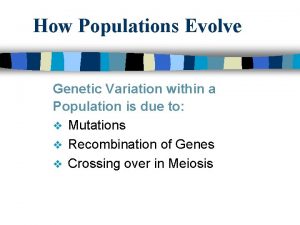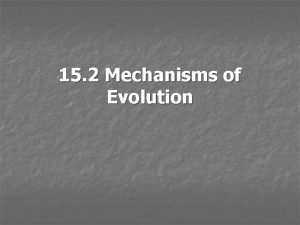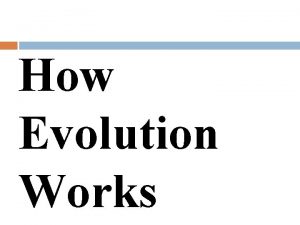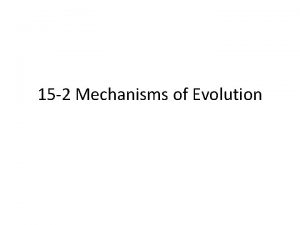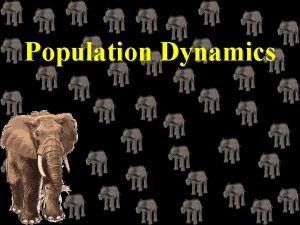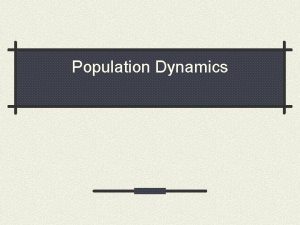POPULATION EVOLUTION INDIVIDUALS DONT EVOLVE POPULATIONS DO As





























- Slides: 29

POPULATION EVOLUTION

INDIVIDUALS DON’T EVOLVE, POPULATIONS DO. As Charles Darwin and Aflred Wallace perceived long ago, individuals don’t evolve, populations do. A population is a group of individuals of the same species in a

VARIATION IN POPULATIONS • Individuals in a population have traits in common. – Morphological traits – Physiological traits – Behavioral traits

VARIATIONS IN POPULATIONS For sexually reproducing species, a population is a group of individuals that are interbreeding, reproductively isolated from other species,

VARIATION IN POPULATIONS • Dimorphism The persistence of two forms of a trait in a population. – For example: humans have sexual dimorphism in which males and females have specific characteristics, and can (usually) be told apart easily. – • Polymorphism The persistence of three or more forms of a trait. – For example: humans have polymorphism in skin color. –

THE GENE POOL Genetic variation makes up a population’s gene pool—the combined alleles (traits) of all the individuals in a population.

THE GENE POOL—SOURCES OF VARIATION Any individual might or might not inherit alleles for any trait. Mutation also leads to new alleles. New alleles may come as a result of genetic recombination during sexual reproduction.

MUTATION Mutations are a major source of variation in populations. Most mutations are neutral and have no effect on the individual. Some mutations lead to death. . Every so often, a beneficial mutation will occur, and if it gives an organism an

STABILITY AND CHANGE IN ALLELE FREQUENCIES Researchers typically track allele frequencies. An allele frequency is a measure of how common a certain allele is in the population. For example: Count the number of students with red hair, blond hair,

STABILITY AND CHANGE IN ALLELE FREQUENCIES Microevolution refers to small-scale changes in allele frequencies that arise as an outcome of mutation, natural selection, genetic drift or gene flow, or some combination of these.

WHEN IS A POPULATION NOT EVOLVING? When a population stops evolving, they are under genetic equilibrium. Genetic equilibrium is exceedingly rare in nature, and can lead to the extinction of a species. is no mutation. 2. The population is infinitely large. 3. The population is isolated from all other populations of the species (no gene flow). 4. Mating is random. 5. All individuals survive and produce the same number of 1. There

THE HARDY-WEINBURG FORMULA When scientists are studying a population undergoing change, They may utilize the Hardy-Weinburg formula to attempt to discern the reason behind that change. Remember, the 5 conditions of equilibrium are: 1. There is no mutation. 2. The population is infinitely large. 3. The population is isolated from all other populations of the species (no gene flow). 4. Mating is random.

NATURAL SELECTION REVISITED Natural selection is the most influential process in microevolution. Natural selection cause populations to undergo… Directional selection Stabilizing selection Disruptive selection

DIRECTIONA L SELECTION In directional selection, allele frequencies shift in a consistent direction, so forms at one end of a phenotypic range become more common than mid-range forms. Both of these scenarios are examples of directional selection

THE PEPPERED MOTH Populations of peppered moths are a classic example of directional selection. The moths feed and mate at night and rest motionless on trees during the day. Their behavior and coloration (mottled gray to nearly black) camouflage them from day -flying, moth-eating birds.

THE PEPPERED MOTH Lichens are sensitive to air pollution. Between 18481898, soot an other pollutants started to kill the lichens and darken the tree trunks.

POCKET MICE In the Sonoran Desert there are two main colors of pocket mice: tawny and black. Rock pocket mice are small mammals that spend the day in underground burrows and forage for seeds at night. Those who live in tawnycolored outcroppings of granite, are…well…tawny colored! Those who live in the dark basalt of ancient lava flows

RESISTANCE TO PESTICIDES AND ANTIBIOTICS Pesticides can cause directional selection. There are 450 species of pests that are now resistant to one or more types of pesticides— including bed bugs! Ewww. Antibiotics can also cause directional selection. Antibiotics are used to fight pathogenic bacteria, and have been notoriously overprescribed, overused, and not used correctly. Bed bugs were virtually wiped out in America in the 1930’s thanks to the pesticide DDT. Research into recent infestations in large cities show that bed bugs are now resistant to many of the traditional pesticides used to the control them.

STABILIZING SELECTION With stabilizing selection, intermediate forms of a trait in a population are favored, and extreme forms are not. Small baby dragons aren’t strong enough to compete with their siblings to get food and they die. Large baby dragons need too much food to survive, and they die.

SOCIABLE WEAVERS Between 1993 -2000, scientists captured, measured, tagged, released, and recaptured 70 to 100 percent of the birds living in communal nests during the breeding season. Foraging is not easy in this habitat, and lean birds do not store enough fat to avoid starvation. The largest birds are more attractive to Social weaver nest (above) and birds (below).

DISRUPTIVE SELECTION disruptive selection, forms at both ends of the range of variation are favored, and intermediate forms are selected against. With Small dragons are able to find food in the smallest rock crags, and large dragons are able to hunt big game for food. Medium sized dragons compete aggressively with other predators to get food, and die more frequently.

BLACK-BELLIED SEED CRACKER The black-bellied seed crackers of Cameroon come in two sizes and two sizes only—large billed or small billed, with nothing in between. swamp forests flood in the wet season; lightning-sparked fires burn in the hot, dry season. Most plants are fire-resistant, grasslike sedges. One species produces hard seeds and the other, soft seeds. 12 mm beak size Cameroon’s 15 mm beak size

SEXUAL SELECTION The individuals of many sexually reproducing species show a distinct sexual dimorphism. Often the males are larger and flashier than females. Courtship rituals and male aggression are common. By this mode of natural selection, winners are the ones that are better at attracting mates and successfully reproducing compared to others of the population. http: //www. youtube. com/watch? v=n. S 1 t. Enfkk 6 M

SEXUAL SELECTION By choosing mates, a male or female is a selective agent acting on its own species. The selected males and females pass on their alleles to the next generation.

GENETIC DRIFT—THE CHANCE CHANGES Genetic drift is a random change in allele frequencies over time, brought about by chance alone. There are two types of genetic drift, the bottleneck effect and the founder effect. The Black Plague would have caused genetic drift in the European countries that it greatly affected.

BOTTLENECKS Bottlenecks occur when there is a drastic reduction in population size is brought on by extreme pressure. In the 1890’s, hunters killed all but twenty of a large population of northern elephant seals. Government restrictions allowed the population to recover to about 130, 000 individuals.

THE FOUNDER EFFECT The founder effect is when unpredictable genetic shifts occur after a few individuals establish a new population. Genetic diversity might be greatly reduced relative to the original gene pool,

INBRED POPULATIONS Inbreeding is nonrandom mating among very close relatives, which share many identical alleles. It leads to the homozygous condition, and can lower fitness if harmful recessive alleles are increasing in frequency.

GENE FLOW Individuals of the same species don’t always stay put. A population loses alleles when an individual leaves it for good—emigration. A population gains alleles when an individual permanently moves in—immigration. In both cases, gene flow—the physical movement of alleles into and out of a population—occurs.
 Individuals don't evolve populations do
Individuals don't evolve populations do Chapter 13 how populations evolve test
Chapter 13 how populations evolve test Chapter 13 how populations evolve
Chapter 13 how populations evolve Dont laugh at me dont call me names
Dont laugh at me dont call me names Dont ask dont tell political cartoon
Dont ask dont tell political cartoon Chapter 17 evolution of populations answer key
Chapter 17 evolution of populations answer key Evolution of populations section 11 review
Evolution of populations section 11 review Chapter 23 the evolution of populations
Chapter 23 the evolution of populations Chapter 23 the evolution of populations
Chapter 23 the evolution of populations Stabilizing selection human birth weight
Stabilizing selection human birth weight Evolution of populations section 16-1 genes and variation
Evolution of populations section 16-1 genes and variation Why are populations the smallest unit of evolution
Why are populations the smallest unit of evolution Chapter 16 evolution of populations vocabulary review
Chapter 16 evolution of populations vocabulary review Chapter 16 evolution of populations
Chapter 16 evolution of populations Genetics
Genetics Chapter 4 population ecology section 1 population dynamics
Chapter 4 population ecology section 1 population dynamics Section 1 population dynamics answer key
Section 1 population dynamics answer key Population ecology section 1 population dynamics
Population ecology section 1 population dynamics Population ecology section 1 population dynamics
Population ecology section 1 population dynamics Evolve
Evolve When will oddish evolve
When will oddish evolve Explore evolve validate prototype
Explore evolve validate prototype Organization of declarative knowledge
Organization of declarative knowledge Learn empower evolve
Learn empower evolve Evolve
Evolve Prosimians
Prosimians Evolve knowledge
Evolve knowledge Open assess
Open assess Evolve knowledge
Evolve knowledge Hiv siv
Hiv siv

